Life Cycle Assessment of Pervious Pavements: Integrative Review and Novel Ideas of Analysis
Abstract
1. Introduction
2. Materials and Methods
2.1. Research Questions and Criteria
2.2. Data Collection and Variables
- Life Cycle Assessment comparisons;
- Life Cycle Cost Assessment comparisons;
- Reviews and simple comparisons.
3. Results and Discussion
3.1. Regional Productions and Metadata on Selected Documents
3.2. LCA Frameworks of Pervious Pavements
3.2.1. Analysis Horizon
3.2.2. Design Storm Duration and Recurrence Period
3.2.3. Functional Unit
3.2.4. Databases
3.2.5. Software and Life Cycle Impact Assessment
3.2.6. System Boundaries
3.2.7. Framework Suggestion for Future LCA Studies
3.3. LCCA Frameworks of Pervious Pavements
- Pervious pavement with other GI;
- Pervious pavement design options;
- Pervious pavements and non-pervious traditional alternatives.
3.4. Surface Materials and Pervious Pavement Design
3.4.1. Choice between Asphalt and Concrete Surfaces
3.4.2. Use of By-Products and Recycled Materials
4. Hotspots and Decision-Making
5. Conclusions
- LCAs and LCCAs of pervious pavements identify hotspots and offer opportunities for environmental and cost-benefit improvements. There is an increasing interest in using LCA and LCCA to obtain optimal urban layouts.
- Raw material extraction, manufacturing, and transport contribute to significant environmental burdens in a cradle-to-gate LCA of pervious pavements. Optimising materials and designing pervious pavements may diminish the environmental impacts.
- Use phase and maintenance stages vary in their contributions to environmental impacts due to different lifespans and operational considerations.
- End-of-life considerations contribute to environmental burdens and should not be disregarded in LCA studies. Future studies should address this phase and consider the recommendations of this review and other examples from the literature.
- Comparisons of pervious pavements with other GIs should consider different functions and avoid unfair environmental impact assessments. The benefits shown in this study are a starter for complex elements that should be regarded.
- The boundaries of LCAs and LCCAs should be expanded to include additional factors such as noise reduction and social or aesthetic parameters. A Social LCA (SLCA) may also be used as another comparison in further studies.
- Integrating multiple parameters in LCAs and LCCAs facilitates decision-making for stormwater management and resilient cities. However, the plurality of MCDM methods hinders the comparison of metrics and parameters. Future studies should address decision-making and pervious pavements, considering the different MCDM alternatives.
- Further benefits and studies should be analysed and incorporated to improve the frameworks of this paper. Understanding all synergies in pervious pavements still needs further research; thus, it is a work in progress.
Supplementary Materials
Author Contributions
Funding
Data Availability Statement
Acknowledgments
Conflicts of Interest
References
- Fletcher, T.D.; Shuster, W.; Hunt, W.F.; Ashley, R.; Butler, D.; Arthur, S.; Trowsdale, S.; Barraud, S.; Semadeni-Davies, A.; Bertrand-Krajewski, J.L.; et al. SUDS, LID, BMPs, WSUD and More—The Evolution and Application of Terminology Surrounding Urban Drainage. Urban Water J. 2015, 12, 525–542. [Google Scholar] [CrossRef]
- Sitzenfrei, R.; Kleidorfer, M.; Bach, P.M.; Bacchin, T.K. Green Infrastructures for Urban Water System: Balance between Cities and Nature. Water 2020, 12, 1456. [Google Scholar] [CrossRef]
- Ellis, J.B. Sustainable Surface Water Management and Green Infrastructure in UK Urban Catchment Planning. J. Environ. Plan. Manag. 2013, 56, 24–41. [Google Scholar] [CrossRef]
- Zilli, M.T.; Carvalho, L.M.V.; Liebmann, B.; Silva Dias, M.A. A Comprehensive Analysis of Trends in Extreme Precipitation over Southeastern Coast of Brazil. Int. J. Climatol. 2017, 37, 2269–2279. [Google Scholar] [CrossRef]
- de Almeida, L.Q.; Welle, T.; Birkmann, J. Disaster Risk Indicators in Brazil: A Proposal Based on the World Risk Index. Int. J. Disaster Risk Reduct. 2016, 17, 251–272. [Google Scholar] [CrossRef]
- BBC China Floods: 12 Dead in Zhengzhou Train and Thousands Evacuated in Henan—BBC News; BBC: London, UK, 2021.
- BBC Germany Floods: Dozens Killed after Record Rain in Germany and Belgium; BBC: London, UK, 2021.
- Akbari, H.; Cartalis, C.; Kolokotsa, D.; Muscio, A.; Pisello, A.L.; Rossi, F.; Santamouris, M.; Synnefa, A.; Wong, N.H.; Zinzi, M. Local Climate Change and Urban Heat Island Mitigation Techniques—The State of the Art. J. Civ. Eng. Manag. 2016, 22, 1–16. [Google Scholar] [CrossRef]
- Chapman, S.; Thatcher, M.; Salazar, A.; Watson, J.E.M.; McAlpine, C.A. The Impact of Climate Change and Urban Growth on Urban Climate and Heat Stress in a Subtropical City. Int. J. Climatol. 2019, 39, 3013–3030. [Google Scholar] [CrossRef]
- Wang, C.; Wang, Z.H.; Kaloush, K.E.; Shacat, J. Cool Pavements for Urban Heat Island Mitigation: A Synthetic Review. Renew. Sustain. Energy Rev. 2021, 146, 111171. [Google Scholar] [CrossRef]
- Bernucci, L.L.B.; da Motta, L.M.G.; Ceratti, J.A.P.; Soares, J.B. Asphalt Paving: Basic Training for Engineers (Pavimentação Asfáltica: Formação Básica Para Engenheiros, in Portuguese); PETROBRÁS Asfaltos and ABEDA (Associação Brasileira das Empresas Distribuidoras de Asfaltos): Rio de Janeiro, Brazil, 2008. [Google Scholar]
- Ghisi, E.; Belotto, T.; Thives, L.P. The Use of Permeable Interlocking Concrete Pavement to Filter Stormwater for Non-Potable Uses in Buildings. Water 2020, 12, 2045. [Google Scholar] [CrossRef]
- Hammes, G.; Thives, L.P.; Ghisi, E. Application of Stormwater Collected from Porous Asphalt Pavements for Non-Potable Uses in Buildings. J. Environ. Manag. 2018, 222, 338–347. [Google Scholar] [CrossRef]
- Xing, Y.-J.; Chen, T.-L.; Gao, M.-Y.; Pei, S.-L.; Pan, W.-B.; Chiang, P.-C. Comprehensive Performance Evaluation of Green Infrastructure Practices for Urban Watersheds Using an Engineering–Environmental–Economic (3E) Model. Sustainability 2021, 13, 4678. [Google Scholar] [CrossRef]
- Barrett, M. Water Quality Associated with Permeable Interlocking Concrete Pavers. In Proceedings of the World Environmental and Water Resources Congress, Austin, TX, USA, 17–21 May 2015; pp. 453–463. [Google Scholar]
- Singh, A.; Vaddy, P.; Biligiri, K.P. Quantification of Embodied Energy and Carbon Footprint of Pervious Concrete Pavements through a Methodical Lifecycle Assessment Framework. Resour. Conserv. Recycl. 2020, 161, 104953. [Google Scholar] [CrossRef]
- Garcia, E.S.H.; Thives, L.P.; Ghisi, E.; Antunes, L.N. Analysis of Permeability Reduction in Drainage Asphalt Mixtures Due to Decrease in Void Volume. J. Clean. Prod. 2020, 248, 119292. [Google Scholar] [CrossRef]
- Li, H.; Harvey, J.T.; Holland, T.J.; Kayhanian, M. The Use of Reflective and Permeable Pavements as a Potential Practice for Heat Island Mitigation and Stormwater Management. Environ. Res. Lett. 2013, 8, 015023. [Google Scholar] [CrossRef]
- Wang, T.; Harvey, J.T.; Jones, D. A Framework for Life-Cycle Cost Analyses and Environmental Life-Cycle Assessments for Permeable Pavements; University of California: Davis, CA, USA, 2010. [Google Scholar]
- Liu, J.; Li, H.; Wang, Y.; Zhang, H. Integrated Life Cycle Assessment of Permeable Pavement: Model Development and Case Study. Transp. Res. Part D Transp. Environ. 2020, 85, 102381. [Google Scholar] [CrossRef]
- Vaz, I.; Ghisi, E.; Thives, L. Life Cycle Energy Assessment and Economic Feasibility of Stormwater Harvested from Pervious Pavements. Water Res. 2020, 170, 115322. [Google Scholar] [CrossRef]
- Rehan, T.; Qi, Y.; Werner, A. Life-Cycle Cost Analysis for Traditional and Permeable Pavements. In Proceedings of the Construction Research Congress 2018: Sustainable Design and Construction and Education—Selected Papers from the Construction Research Congress 2018, New Orleans, LA, USA, 2–4 April 2018; Volume 2018-April, pp. 422–431. [Google Scholar]
- Antunes, L.N.; Ghisi, E.; Thives, L.P. Permeable Pavements Life Cycle Assessment: A Literature Review. Water 2018, 10, 1575. [Google Scholar] [CrossRef]
- Antunes, L.; Ghisi, E.; Severis, R. Environmental Assessment of a Permeable Pavement System Used to Harvest Stormwater for Non-Potable Water Uses in a Building. Sci. Total Environ. 2020, 746, 141087. [Google Scholar] [CrossRef]
- Bhatt, A.; Bradford, A.; Abbassi, B.E. Cradle-to-Grave Life Cycle Assessment (LCA) of Low-Impact-Development (LID) Technologies in Southern Ontario. J. Environ. Manag. 2019, 231, 98–109. [Google Scholar] [CrossRef]
- Turco, M.; Brunetti, G.; Palermo, S.A.; Capano, G.; Grossi, G.; Maiolo, M.; Piro, P. On the Environmental Benefits of a Permeable Pavement: Metals Potential Removal Efficiency and Life Cycle Assessment. Urban Water J. 2020, 17, 619–627. [Google Scholar] [CrossRef]
- Li, Y.; Huang, J.J.; Hu, M.; Yang, H.; Tanaka, K. Design of Low Impact Development in the Urban Context Considering Hydrological Performance and Life-Cycle Cost. J. Flood Risk Manag. 2020, 13, e12625. [Google Scholar] [CrossRef]
- Elsevier Scopus. Expertly Curated Abstract & Citation Database; Elsevier: Amsterdam, The Netherlands, 2022; About Scopus. [Google Scholar]
- Elsevier Scopus. O Maior Banco de Dados Da Literatura Revisada Por Pares; Elsevier: Amsterdam, The Netherlands, 2020; About Scopus. [Google Scholar]
- Matthews, Tracy. LibGuides: Resources for Librarians: Web of Science Coverage Details. Available online: https://clarivate.libguides.com/librarianresources/coverage (accessed on 13 May 2024).
- Chandrappa, A.K.; Biligiri, K.P. Pervious Concrete as a Sustainable Pavement Material—Research Findings and Future Prospects: A State-of-the-Art Review. Constr. Build. Mater. 2016, 111, 262–274. [Google Scholar] [CrossRef]
- Montalto, F.; Behr, C.; Alfredo, K.; Wolf, M.; Arye, M.; Walsh, M. Rapid Assessment of the Cost-Effectiveness of Low Impact Development for CSO Control. Landsc. Urban Plan. 2007, 82, 117–131. [Google Scholar] [CrossRef]
- Litmaps | Your Literature Review Assistant. Available online: https://www.litmaps.com/ (accessed on 3 April 2024).
- ISO 14040; Environmental Management—Life Cycle Assessment—Principles and Framework. International Organisation for Standardisation: Geneva, Switzerland, 2006.
- Sousa, M.R.C.D.; Montalto, F.A.; Spatari, S. Using Life Cycle Assessment to Evaluate Green and Grey Combined Sewer Overflow Control Strategies. J. Ind. Ecol. 2012, 16, 901–913. [Google Scholar] [CrossRef]
- Wang, Y.; Li, H.; Abdelhady, A.; Li, H.; Harvey, J. Initial Evaluation Methodology and Case Studies for Life Cycle Impact of Permeability of Permeable Pavements. Int. J. Transp. Sci. Technol. 2018, 7, 169–178. [Google Scholar] [CrossRef]
- Antunes, L.; Sydney, C.; Ghisi, E.; Phoenix, V.; Thives, L.; White, C.; Garcia, E. Reduction of Environmental Impacts Due to Using Permeable Pavements to Harvest Stormwater. Water 2020, 12, 2840. [Google Scholar] [CrossRef]
- Hengen, T.J.; Sieverding, H.L.; Stone, J.J. Lifecycle Assessment Analysis of Engineered Stormwater Control Methods Common to Urban Watersheds. Am. Soc. Civ. Eng. 2016, 142, 04016016. [Google Scholar] [CrossRef]
- Chen, X.; Wang, H. Life-Cycle Assessment and Multi-Criteria Performance Evaluation of Pervious Concrete Pavement with Fly Ash. Resour. Conserv. Recycl. 2022, 177, 105969. [Google Scholar] [CrossRef]
- Gutiérrez, J.M.; Jones, R.G.; Narisma, G.T.; Alves, L.M.; Amjad, M.; Gorodetskaya, I.V.; Grose, M.; Klutse, N.A.B.; Krakovska, S.; Li, J.; et al. IPCC AR6-WGI Atlas; Climate Change 2021: The Physical Science Basis. Contribution of Working Group I to the Sixth Assessment Report of the Intergovernmental Panel on Climate Change; Cambridge University Press: Cambridge, UK, 2021. [Google Scholar]
- Finnveden, G.; Hauschild, M.Z.; Ekvall, T.; Guinée, J.; Heijungs, R.; Hellweg, S.; Koehler, A.; Pennington, D.; Suh, S. Recent Developments in Life Cycle Assessment. J. Environ. Manag. 2009, 91, 1–21. [Google Scholar] [CrossRef]
- ABNT NBR 14040; Gestão Ambiental—Avaliação Do Ciclo de Vida—Princípios e Estrutura. Associação Brasileira de Normas Técnicas: Rio de Janeiro, Brizil, 2009; p. 30.
- Wernet, G.; Bauer, C.; Steubing, B.; Reinhard, J.; Moreno-Ruiz, E.; Weidema, B. The Ecoinvent Database Version 3 (Part I): Overview and Methodology. Int. J. Life Cycle Assess. 2016, 21, 1218–1230. [Google Scholar] [CrossRef]
- Huijbregts, M.A.J.; Steinmann, Z.J.N.; Elshout, P.M.F.; Stam, G.; Verones, F.; Vieira, M.; Zijp, M.; Hollander, A.; van Zelm, R. ReCiPe2016: A Harmonised Life Cycle Impact Assessment Method at Midpoint and Endpoint Level. Int. J. Life Cycle Assess. 2017, 22, 138–147. [Google Scholar] [CrossRef]
- Cherubini, E.; Franco, D.; Zanghelini, G.M.; Soares, S.R. Uncertainty in LCA Case Study Due to Allocation Approaches and Life Cycle Impact Assessment Methods. Int. J. Life Cycle Assess. 2018, 23, 2055–2070. [Google Scholar] [CrossRef]
- Bueno, C.; Hauschild, M.; Rossignolo, J.; Ometto, A.; Mendes, N. Sensitivity Analysis of the Use of Life Cycle Impact Assessment Methods: A Case Study on Building Materials. J. Clean. Prod. 2016, 112, 2208–2220. [Google Scholar] [CrossRef]
- BS EN 15804:2012+A2; Sustainability of Construction Works. Environmental Product Declarations. Core Rules for the Product Category of Construction Products. CEN: Brussels, Belgium, 2019.
- Lu, G.; Wang, Y.; Li, H.; Wang, D.; Oeser, M. The Environmental Impact Evaluation on the Application of Permeable Pavement Based on Life Cycle Analysis. Int. J. Transp. Sci. Technol. 2019, 8, 351–357. [Google Scholar] [CrossRef]
- Hung, A.; Li, L.Y.; Swei, O. Evaluation of Permeable Highway Pavements via an Integrated Life-Cycle Model. J. Clean. Prod. 2021, 314, 128043. [Google Scholar] [CrossRef]
- Cascone, S.; Leuzzo, A. Thermal Comfort in the Built Environment: A Digital Workflow for the Comparison of Different Green Infrastructure Strategies. Atmosphere 2023, 14, 685. [Google Scholar] [CrossRef]
- Yuan, X.; Tang, Y.; Li, Y.; Wang, Q.; Zuo, J.; Song, Z. Environmental and Economic Impacts Assessment of Concrete Pavement Brick and Permeable Brick Production Process—A Case Study in China. J. Clean. Prod. 2018, 171, 198–208. [Google Scholar] [CrossRef]
- Mei, C.; Liu, J.; Wang, H.; Yang, Z.; Ding, X.; Shao, W. Integrated Assessments of Green Infrastructure for Flood Mitigation to Support Robust Decision-Making for Sponge City Construction in an Urbanized Watershed. Sci. Total Environ. 2018, 639, 1394–1407. [Google Scholar] [CrossRef] [PubMed]
- Chen, X.D.; Wang, H.; Najm, H. Environmental Assessment and Economic Analysis of Porous Pavement at Sidewalk. In Chapter of Pavement Life-Cycle Assessment, Proceedings of the Symposium on Life-Cycle Assessment of Pavements (Pavement LCA 2017), Champaign, IL, USA, 12–13 April 2017, 1st ed.; CRC Press: Boca Raton, FL, USA, 2017. [Google Scholar] [CrossRef]
- Zhan, W.; Chui, T.F.M. Evaluating the Life Cycle Net Benefit of Low Impact Development in a City. Urban For. Urban Green. 2016, 20, 295–304. [Google Scholar] [CrossRef]
- Xu, C.; Tang, T.; Jia, H.; Xu, M.; Xu, T.; Liu, Z.; Long, Y.; Zhang, R. Benefits of Coupled Green and Grey Infrastructure Systems: Evidence Based on Analytic Hierarchy Process and Life Cycle Costing. Resour. Conserv. Recycl. 2019, 151, 104478. [Google Scholar] [CrossRef]
- Kourtis, I.M.; Tsihrintzis, V.A.; Baltas, E. A Robust Approach for Comparing Conventional and Sustainable Flood Mitigation Measures in Urban Basins. J. Environ. Manag. 2020, 269, 110822. [Google Scholar] [CrossRef] [PubMed]
- Chui, T.F.M.; Liu, X.; Zhan, W. Assessing Cost-Effectiveness of Specific LID Practice Designs in Response to Large Storm Events. J. Hydrol. 2016, 533, 353–364. [Google Scholar] [CrossRef]
- Yao, Y.; Hu, C.; Liu, C.; Yang, F.; Ma, B.; Wu, Q.; Li, X.; Soomro, S. Comprehensive Performance Evaluation of Stormwater Management Measures for Sponge City Construction: A Case Study in Gui’an New District, China. J. Flood Risk Manag. 2022, 15, e12834. [Google Scholar] [CrossRef]
- Zhu, Y.; Xu, C.; Liu, Z.; Yin, D.; Jia, H.; Guan, Y. Spatial Layout Optimization of Green Infrastructure Based on Life-Cycle Multi-Objective Optimization Algorithm and SWMM Model. Resour. Conserv. Recycl. 2023, 191, 106906. [Google Scholar] [CrossRef]
- Peterson, L.A.; Awerbuch, P.M.; Spatari, S. Environmental and Economic Implications of Stormwater Management Alternatives in Rural Development. J. Ind. Ecol. 2021, 25, 1076–1088. [Google Scholar] [CrossRef]
- Wang, M.; Jiang, Z.; Zhang, D.; Zhang, Y.; Liu, M.; Rao, Q.; Li, J.; Keat Tan, S. Optimization of Integrating Life Cycle Cost and Systematic Resilience for Grey-Green Stormwater Infrastructure. Sustain. Cities Soc. 2023, 90, 104379. [Google Scholar] [CrossRef]
- Imteaz, M.A.; Ahsan, A. MUSIC for Cost Optimisation of Stormwater Treatment Systems. Int. J. Water 2015, 9, 302–314. [Google Scholar] [CrossRef]
- Vares, S.; Pulakka, S. Life Cycle Assessment (LCA) and Costing Analysis (LCCA) for Conventional and Permeable Pavement Walkways; VTT: Espoo, Finland, 2015; pp. 1–25. [Google Scholar]
- Mccartney, N. Environmental Impact Assessment of Sustainable Drainage Sidewalk Systems Using LCA. Master’s Thesis, Departament d’Enginyeria Civil i Ambiental, Universitat Politècnica de Catalunya, Catalunya, Spain, 2016; pp. 1–130. [Google Scholar]
- Thives, L.P.; Ghisi, E.; Brecht, D.G.; Pires, D.M. Filtering Capability of Porous Asphalt Pavements. Water 2018, 10, 206. [Google Scholar] [CrossRef]
- Levinson, R.; Gilbert, H.; Jin, L.; Mandel, B.; Millstein, D.; Rosado, P.; Harvey, J.; Kendall, A.; Li, H.; Saboori, A.; et al. Life-Cycle Assessment and Co-Benefits of Cool Pavements; California Air Resources Board and the California Environmental Protection Agency: Sacramento, CA, USA, 2017. [Google Scholar]
- Ellingboe, E.; Arehart, J.H.; Srubar, W.V. On the Theoretical CO2 Sequestration Potential of Pervious Concrete. Infrastructures 2019, 4, 12. [Google Scholar] [CrossRef]
- Chen, X.; Wang, H.; Najm, H.; Venkiteela, G.; Hencken, J. Evaluating Engineering Properties and Environmental Impact of Pervious Concrete with Fly Ash and Slag. J. Clean. Prod. 2019, 237, 117714. [Google Scholar] [CrossRef]
- Anastasiou, E.K.; Liapis, A.; Papachristoforou, M. Life Cycle Assessment of Concrete Products for Special Applications Containing EAF Slag. Procedia Environ. Sci. 2017, 38, 469–476. [Google Scholar] [CrossRef]
- Chen, J.S.; Yang, C.H.; Lee, C.T. Field Evaluation of Porous Asphalt Course for Life-Cycle Cost Analysis. Constr. Build. Mater. 2019, 221, 20–26. [Google Scholar] [CrossRef]
- Paula Junior, A.C.; Jacinto, C.; Oliveira, T.M.; Polisseni, A.E.; Brum, F.M.; Teixeira, E.R.; Mateus, R. Characterisation and Life Cycle Assessment of Pervious Concrete with Recycled Concrete Aggregates. Crystals 2021, 11, 209. [Google Scholar] [CrossRef]
- Yap, S.P.; Chen, P.Z.C.; Goh, Y.; Ibrahim, H.A.; Mo, K.H.; Yuen, C.W. Characterization of Pervious Concrete with Blended Natural Aggregate and Recycled Concrete Aggregates. J. Clean. Prod. 2018, 181, 155–165. [Google Scholar] [CrossRef]
- De Pascale, B.; Tataranni, P.; Bonoli, A.; Lantieri, C. Comparative Life Cycle Assessment (LCA) of Porous Asphalt Mixtures with Sustainable and Recycled Materials: A Cradle-to-Gate Approach. Materials 2023, 16, 6540. [Google Scholar] [CrossRef]
- Bizarro, D.E.G.; Steinmann, Z.; Nieuwenhuijse, I.; Keijzer, E.; Hauck, M. Potential Carbon Footprint Reduction for Reclaimed Asphalt Pavement Innovations: Lca Methodology, Best Available Technology, and near-Future Reduction Potential. Sustainability 2021, 13, 1382. [Google Scholar] [CrossRef]
- De Pascale, B.; Tataranni, P.; Lantieri, C.; Bonoli, A.; Vignali, V. Mechanical Performance and Environmental Assessment of Porous Asphalt Mixtures Produced with EAF Steel Slags and RAP Aggregates. Constr. Build. Mater. 2023, 400, 132889. [Google Scholar] [CrossRef]
- Wu, C.; Liu, C.; Cheng, G.; Li, J.; Zhang, C.; Jiang, W.; Yang, S.; Wang, X.; Wang, W. Preparation of a Low-Carbon Plant-Compatible Ecological Concrete with Fertilizer Self-Release Characteristics Based on Multi-Solid Waste Co-Recycling and Its Environmental Impact. J. Build. Eng. 2023, 76, 107268. [Google Scholar] [CrossRef]
- Ibrahim, H.A.; Razak, H.A.; Abutaha, F. Strength and Abrasion Resistance of Palm Oil Clinker Pervious Concrete under Different Curing Method. Constr. Build. Mater. 2017, 147, 576–587. [Google Scholar] [CrossRef]
- Huang, W.; Wang, H. Multi-Aspect Engineering Properties and Sustainability Impacts of Geopolymer Pervious Concrete. Compos. Part B Eng. 2022, 242, 110035. [Google Scholar] [CrossRef]
- El-Hassan, H.; Kianmehr, P. Pervious Concrete Pavement Incorporating GGBS to Alleviate Pavement Runoff and Improve Urban Sustainability. Road Mater. Pavement Des. 2018, 19, 167–181. [Google Scholar] [CrossRef]
- Wang, R.; Eckelman, M.J.; Zimmerman, J.B. Consequential Environmental and Economic Life Cycle Assessment of Green and Gray Stormwater Infrastructures for Combined Sewer Systems. Environ. Sci. Technol. 2013, 47, 11189–11198. [Google Scholar] [CrossRef] [PubMed]
- Woods-Ballard, B.; Kellagher, R.; Martin, P.; Jefferies, C.; Bray, R.; Shaffer, P. The SuDS Manual; CIRIA: London, UK, 2011; ISBN 978-0-86017-697-8. [Google Scholar]
- Li, X.-J.; Deng, J.-X.; Xie, W.-J.; Jim, C.-Y.; Wei, T.-B.; Lai, J.-Y.; Liu, C.-C. Comprehensive Benefit Evaluation of Pervious Pavement Based on China’s Sponge City Concept. Water 2022, 14, 1500. [Google Scholar] [CrossRef]
- Mardani, A.; Jusoh, A.; MD Nor, K.; Khalifah, Z.; Zakwan, N.; Valipour, A. Multiple Criteria Decision-Making Techniques and Their Applications—A Review of the Literature from 2000 to 2014. Econ. Res. Ekon. Istraživanja 2015, 28, 516–571. [Google Scholar] [CrossRef]
- Joshi, P.; Leitão, J.P.; Maurer, M.; Bach, P.M. Not All SuDS Are Created Equal: Impact of Different Approaches on Combined Sewer Overflows. Water Res. 2021, 191, 116780. [Google Scholar] [CrossRef]
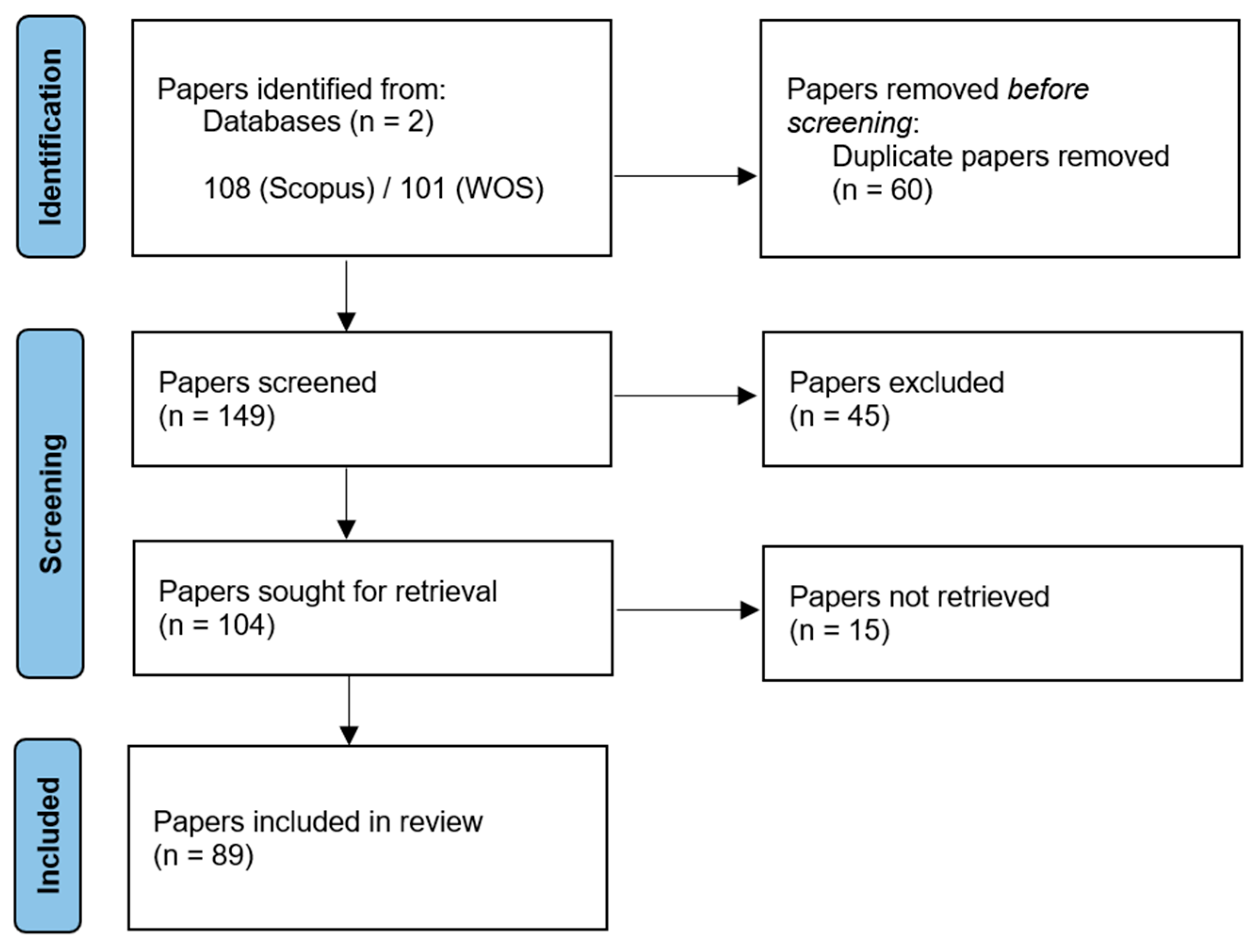
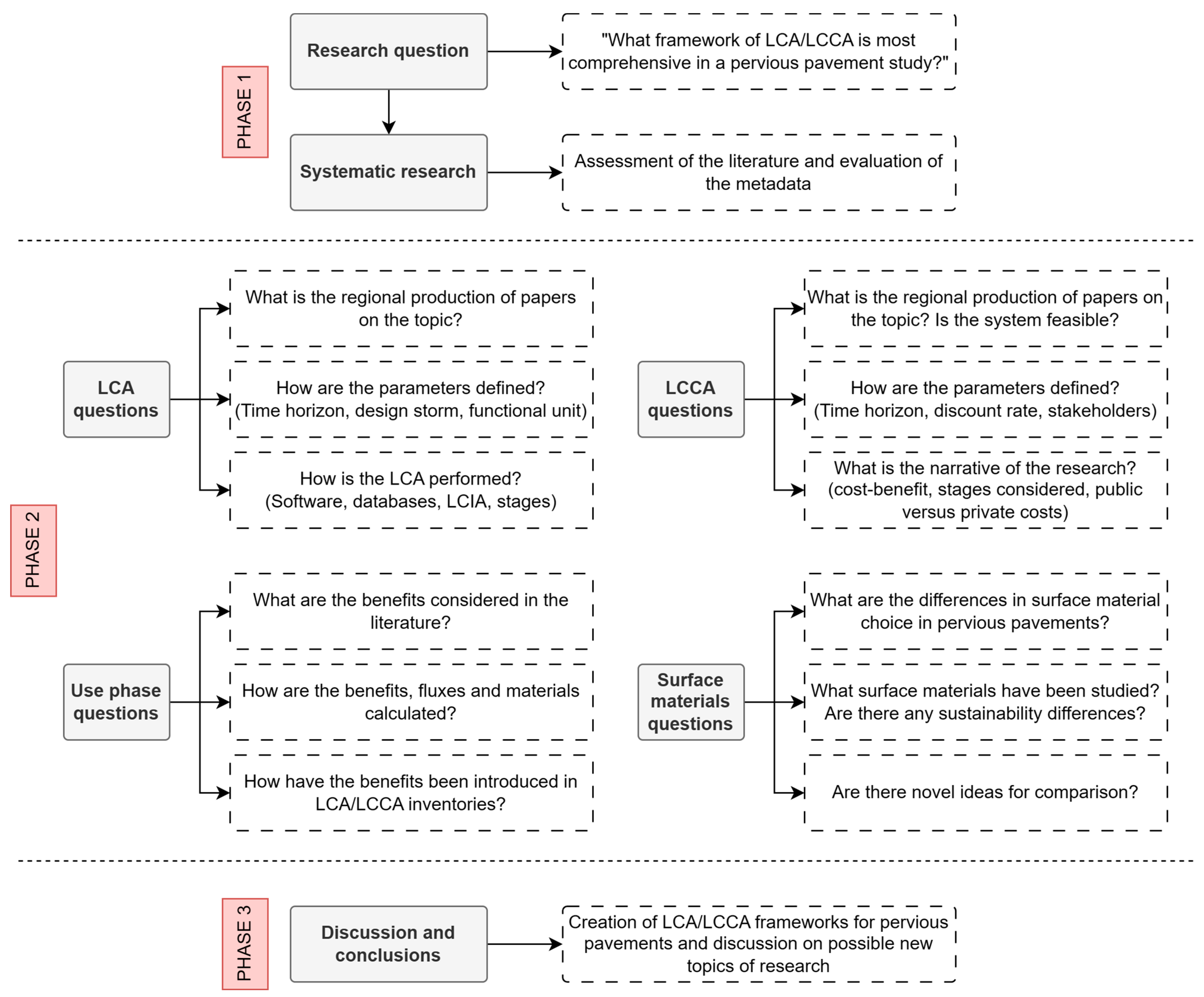
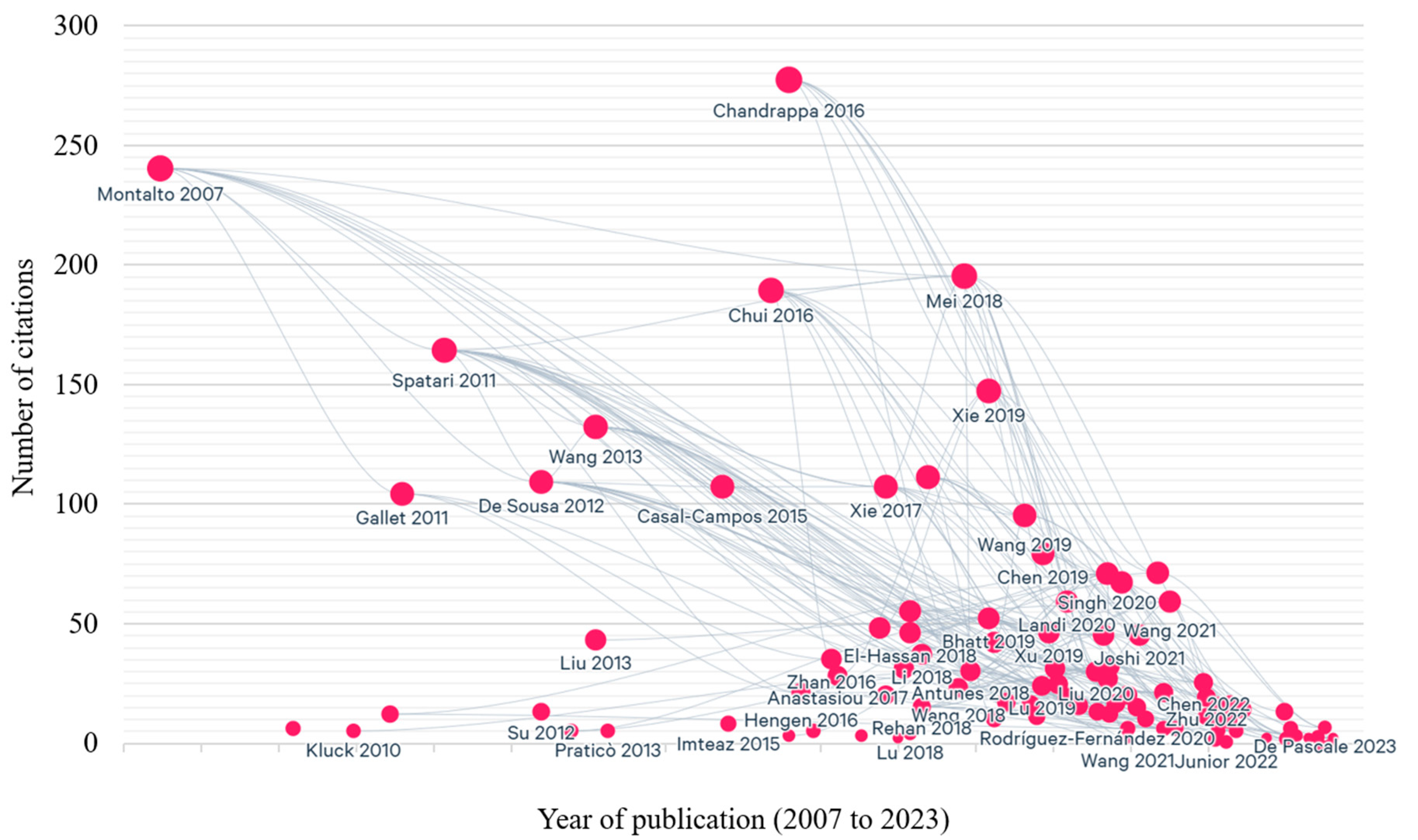
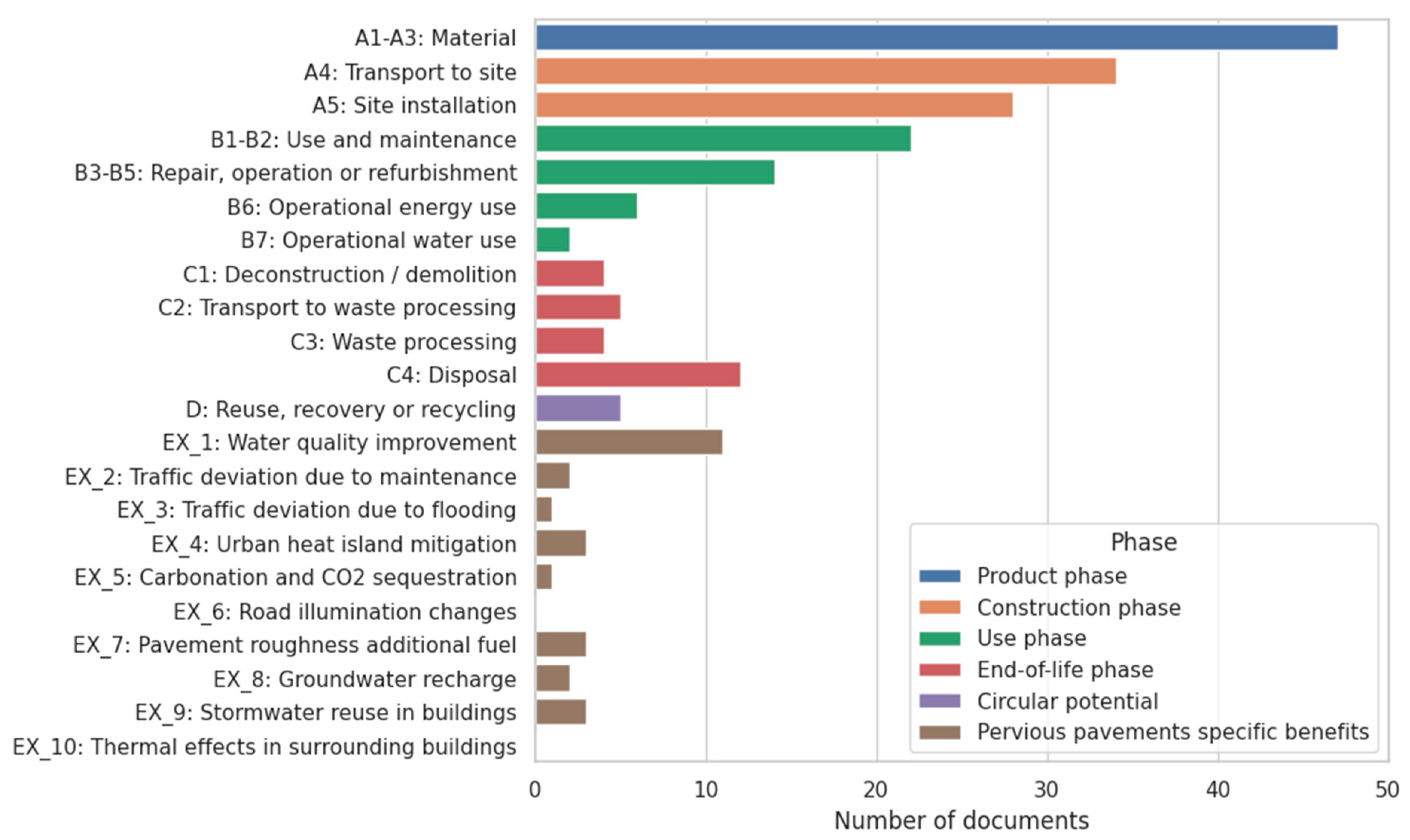
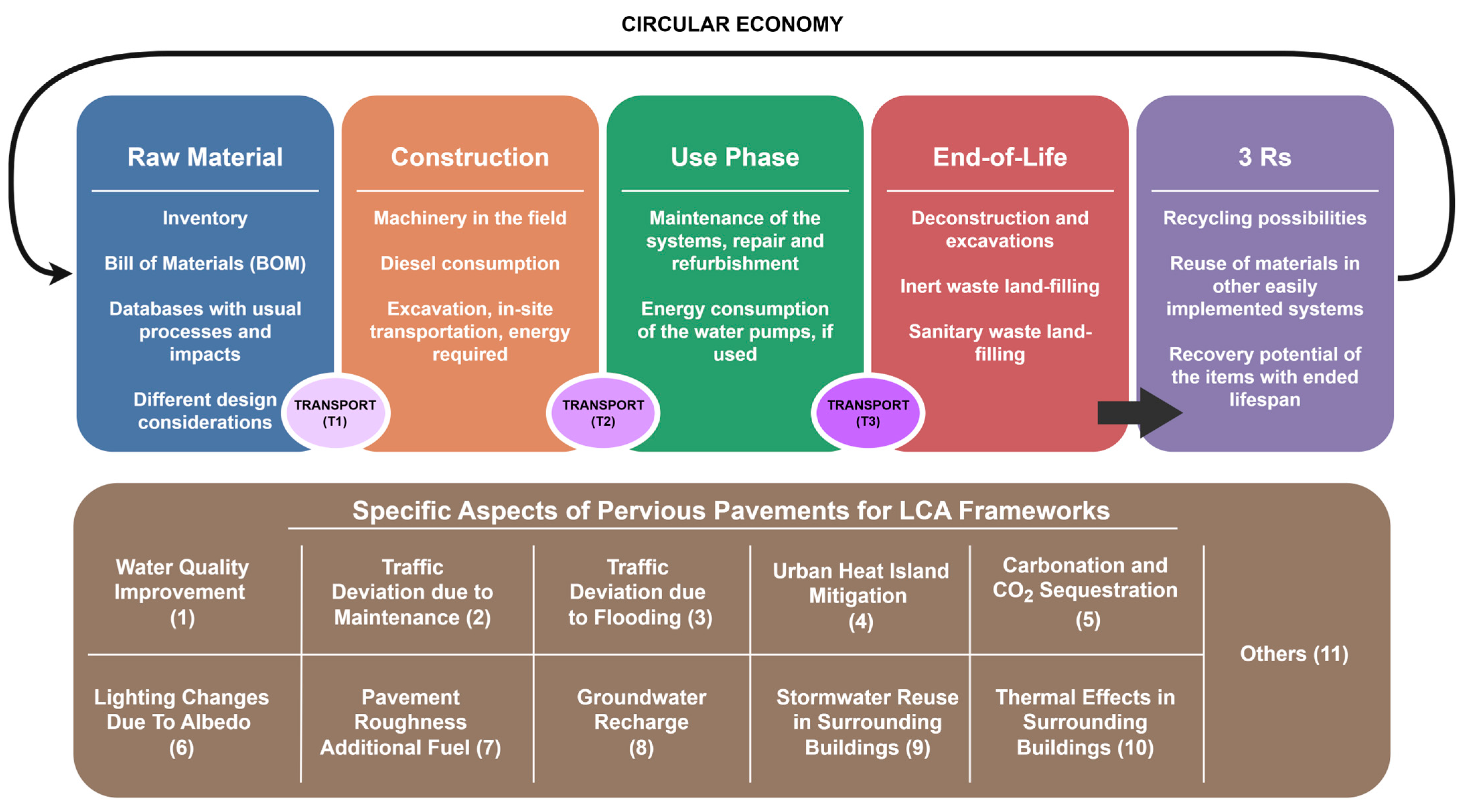


| Category | Docs. | Main Results |
|---|---|---|
| Global warming/Greenhouse gases/Climate change | 42 | Positive impact on reducing greenhouse gas emissions by enabling water infiltration, mitigating urban heat island effect, and supporting carbon sequestration. The use of pervious pavements also reduces the need for energy-intensive drainage systems. The extent of greenhouse gas reduction depends on pavement type, local conditions, and proper maintenance. However, few studies found significant emissions differences between pervious and traditional pavements. |
| Eutrophication | 25 | Positive impact on reducing eutrophication, as pervious pavements allow stormwater to infiltrate the soil, naturally filtering out pollutants and nutrients before reaching water bodies. In the studies, factors such as soil type, proper maintenance, and overall stormwater management practices influence the effectiveness of pervious pavements in reducing eutrophication. |
| Acidification | 23 | Most studies indicate that pervious pavements positively impact the reduction of acidification by infiltrating stormwater into the soil, where acids are naturally neutralised. This minimises the acidic load that reaches water bodies and helps recharge groundwater, acting as a natural buffer to reduce soil acidification further. |
| Ecotoxicity | 22 | Studies have observed that through the filtration of pollutants such as heavy metals, oils, and other chemicals, pervious pavements reduce the harm to aquatic life and ecosystems, positively reducing ecotoxicity. Effectiveness depends on pavement type, soil composition, local conditions, and proper maintenance. |
| Resource depletion | 20 | Some studies indicate that, depending on the scenario, pervious pavement has a more significant impact on the resource depletion category. This is mainly due to the larger number of materials used in the layers, which often have greater thickness than traditional pavement, such as the reservoir layer. However, some authors have incorporated recycled materials, reducing the demand for virgin resources. |
| Human toxicity | 20 | By enabling stormwater infiltration into the soil, pervious pavements naturally filter out pollutants, reducing the potential for human exposure to toxic substances. This results in a positive impact on reducing human toxicity. Some researchers incorporated extra filtration layers like activated carbon or geopolymers to enhance pollutant removal further. |
| Ozone depletion | 17 | Most studies show that pervious pavements do not directly impact ozone depletion since it is primarily caused by releasing ozone-depleting substances such as chlorofluorocarbons (CFCs). However, they can indirectly reduce harmful chemicals and promote sustainable stormwater management. |
| Fine particulate formation | 16 | Studies indicate that pervious pavements effectively act as filters, trapping and retaining fine particles from stormwater. This prevents their release into the air, resulting in improved air quality. |
| Photochemical oxidant creation | 15 | Most studies have observed positive impacts in this category, as pervious pavements reduce the number of runoff-carrying pollutants in urban areas. This leads to fewer chemical reactions and less formation of harmful photochemical oxidants in the air. |
| Energy | 14 | Studies indicate that pervious pavements have a neutral or slightly positive impact on energy consumption compared to traditional pavements. While they may require more energy during construction, they reduce energy consumption over time. Factors include reduced need for public lighting due to lower reflectivity, decreased demand for air conditioning due to less heat retention, and less reliance on drainage and stormwater pumping systems. The impact may vary depending on local conditions and the type of pavement. |
| Land use | 13 | The central positive aspect of this category is the reduction in the need for drainage systems. The reduction leads to a decreased requirement for areas solely dedicated to water drainage, allowing for a more efficient use of urban space. Another point indicated in some studies is the contribution to groundwater recharge. |
| Ionising radiation | 11 | Studies have observed an indirect impact in this category, as pervious pavements reduce exposure to ionising radiation by minimising the runoff of contaminated water. This effect is achieved through stormwater filtration, which retains and removes harmful substances before they can reach water bodies. |
| Water | 10 | Pervious pavements replenish groundwater and maintain water availability by infiltrating stormwater, reducing evaporation and the need for additional irrigation. Some authors studied pervious pavements with water retention systems, further conserving water and minimising water depletion. |
Disclaimer/Publisher’s Note: The statements, opinions and data contained in all publications are solely those of the individual author(s) and contributor(s) and not of MDPI and/or the editor(s). MDPI and/or the editor(s) disclaim responsibility for any injury to people or property resulting from any ideas, methods, instructions or products referred to in the content. |
© 2024 by the authors. Licensee MDPI, Basel, Switzerland. This article is an open access article distributed under the terms and conditions of the Creative Commons Attribution (CC BY) license (https://creativecommons.org/licenses/by/4.0/).
Share and Cite
Martins Vaz, I.C.; Antunes, L.N.; Ghisi, E.; Thives, L.P. Life Cycle Assessment of Pervious Pavements: Integrative Review and Novel Ideas of Analysis. Water 2024, 16, 1403. https://doi.org/10.3390/w16101403
Martins Vaz IC, Antunes LN, Ghisi E, Thives LP. Life Cycle Assessment of Pervious Pavements: Integrative Review and Novel Ideas of Analysis. Water. 2024; 16(10):1403. https://doi.org/10.3390/w16101403
Chicago/Turabian StyleMartins Vaz, Igor Catão, Lucas Niehuns Antunes, Enedir Ghisi, and Liseane Padilha Thives. 2024. "Life Cycle Assessment of Pervious Pavements: Integrative Review and Novel Ideas of Analysis" Water 16, no. 10: 1403. https://doi.org/10.3390/w16101403
APA StyleMartins Vaz, I. C., Antunes, L. N., Ghisi, E., & Thives, L. P. (2024). Life Cycle Assessment of Pervious Pavements: Integrative Review and Novel Ideas of Analysis. Water, 16(10), 1403. https://doi.org/10.3390/w16101403








